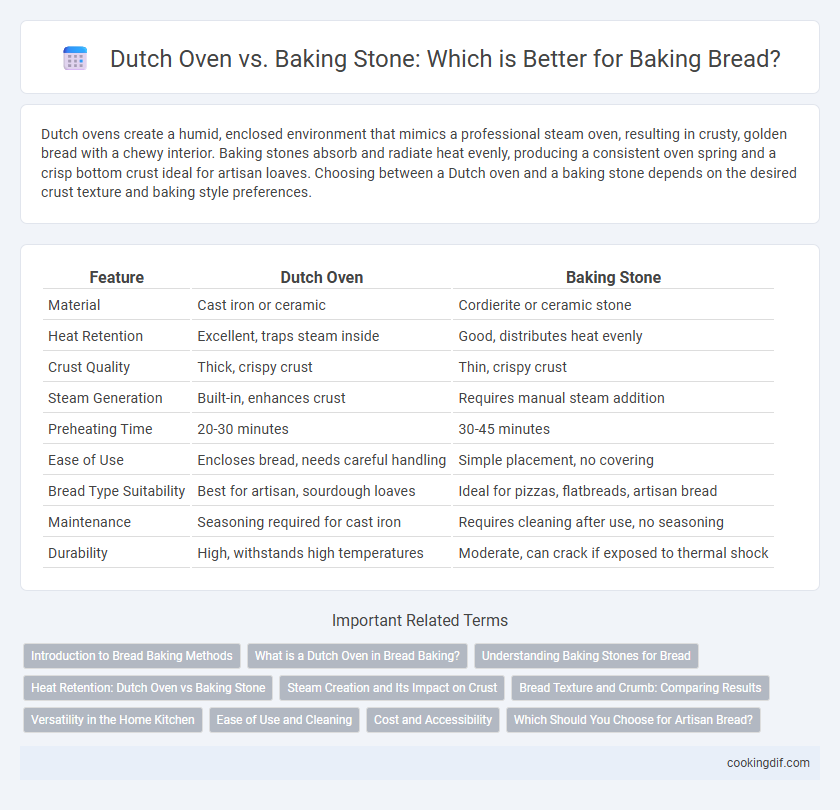Dutch ovens create a humid, enclosed environment that mimics a professional steam oven, resulting in crusty, golden bread with a chewy interior. Baking stones absorb and radiate heat evenly, producing a consistent oven spring and a crisp bottom crust ideal for artisan loaves. Choosing between a Dutch oven and a baking stone depends on the desired crust texture and baking style preferences.
Table of Comparison
| Feature | Dutch Oven | Baking Stone |
|---|---|---|
| Material | Cast iron or ceramic | Cordierite or ceramic stone |
| Heat Retention | Excellent, traps steam inside | Good, distributes heat evenly |
| Crust Quality | Thick, crispy crust | Thin, crispy crust |
| Steam Generation | Built-in, enhances crust | Requires manual steam addition |
| Preheating Time | 20-30 minutes | 30-45 minutes |
| Ease of Use | Encloses bread, needs careful handling | Simple placement, no covering |
| Bread Type Suitability | Best for artisan, sourdough loaves | Ideal for pizzas, flatbreads, artisan bread |
| Maintenance | Seasoning required for cast iron | Requires cleaning after use, no seasoning |
| Durability | High, withstands high temperatures | Moderate, can crack if exposed to thermal shock |
Introduction to Bread Baking Methods
Dutch ovens create a steamy, enclosed environment that mimics professional bread ovens, promoting a crispy crust and even heat distribution for artisan bread. Baking stones provide consistent, radiant heat from below, ensuring a well-baked bottom crust and uniform rise. Both methods enhance bread texture and crust quality, catering to specific baking preferences and recipes.
What is a Dutch Oven in Bread Baking?
A Dutch oven is a heavy, cast-iron pot with a tight-fitting lid that creates a steamy environment crucial for artisan bread baking. It traps moisture released from the dough, resulting in a crisp, golden crust and even heat distribution for thorough baking. Unlike baking stones, which provide a hot surface, Dutch ovens combine steam retention and radiant heat, enhancing oven spring and crust development.
Understanding Baking Stones for Bread
Baking stones, typically made from ceramic or cordierite, provide consistent heat that mimics a traditional brick oven, promoting even crust formation and moisture retention in bread. Their porous surface absorbs and distributes heat evenly, reducing hot spots and creating a crisp, artisan-quality crust. Ideal for baking rustic loaves and pizza, baking stones require preheating to achieve optimal thermal conductivity essential for professional-quality bread baking.
Heat Retention: Dutch Oven vs Baking Stone
Dutch ovens excel in heat retention due to their thick cast iron walls, providing consistent, even heat ideal for crust development in bread baking. Baking stones, made from dense materials like cordierite or ceramic, absorb and radiate heat effectively but cool faster once heat source is removed. For maintaining steady high temperatures and moisture, Dutch ovens outperform baking stones, making them preferred for artisan-style breads.
Steam Creation and Its Impact on Crust
Dutch ovens excel at steam creation by trapping moisture released from dough during baking, resulting in a crispy, blistered crust often favored in artisan bread. Baking stones absorb and radiate heat evenly but lack moisture retention, producing a crust with less shine and chew compared to Dutch ovens. The trapped steam in Dutch ovens enhances crust development by delaying starch gelatinization, allowing for maximum oven spring and a glossy finish.
Bread Texture and Crumb: Comparing Results
Dutch ovens create a steamy, enclosed environment that enhances crust development and produces a moist, airy crumb in bread. Baking stones provide even heat distribution, resulting in a well-baked, crispy crust with a denser crumb texture. The choice between Dutch oven and baking stone impacts the bread's crust thickness, chewiness, and crumb openness significantly.
Versatility in the Home Kitchen
Dutch ovens offer exceptional versatility in the home kitchen for bread baking, providing a sealed environment that traps steam and promotes a crisp crust and moist interior. Baking stones excel at evenly distributing heat across the dough's surface, ideal for artisan-style loaves with a firm crust. Home bakers often prefer Dutch ovens for their multi-functional use, including roasting and braising, while baking stones remain favored for pizza and flatbreads due to their ability to maintain consistent high temperatures.
Ease of Use and Cleaning
Dutch ovens provide excellent heat retention and a sealed environment ideal for artisan bread, with straightforward use by placing dough inside and covering it. They require minimal cleanup since the bread is contained, preventing flour and dough residue from spreading. Baking stones demand preheating and careful dough handling to avoid sticking, often needing extensive cleaning after use due to surface flour and baked-on crumbs.
Cost and Accessibility
Dutch ovens typically range from $40 to $150, offering an all-in-one baking solution that retains heat and moisture effectively, making them accessible for home bakers seeking consistent results. Baking stones are usually more affordable, priced between $20 and $50, but require an existing oven setup and additional accessories like a pizza peel, which can add to the overall cost. Availability is widespread for both, with Dutch ovens found in cookware stores and online, while baking stones are commonly sold in kitchen specialty shops and at lower prices for entry-level models.
Which Should You Choose for Artisan Bread?
Dutch ovens create a sealed, humid environment ideal for artisan bread crust development, while baking stones provide even, radiant heat that ensures thorough bottom crust baking. For artisan bread with a thick, crispy crust and soft interior, the Dutch oven is preferred due to its moisture retention and heat distribution. Baking stones excel in producing a crisp base and are better suited for loaves requiring longer bake times without moisture.
Dutch Oven vs Baking Stone for baking Infographic

 cookingdif.com
cookingdif.com